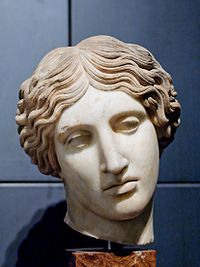

Pliny the Elder records five bronze statues of Amazons in the Artemision of Ephesus.[1] He explains the existence of such a quantity of sculptures on the same theme in the same place by describing a 5th-century BC competition between the artists Polyclitus, Phidias, Kresilas, "Kydon"[2] and Phradmon; thus:
The most celebrated of these artists, though born at different epochs, have joined in a trial of skill in the Amazons which they have respectively made. When these statues were dedicated in the Temple of Diana at Ephesus, it was agreed, in order to ascertain which was the best, that it should be left to the judgment of the artists themselves who were then present: upon which, it was evident that that was the best, which all the artists agreed in considering as the next best to his own. Accordingly, the first rank was assigned to Polycletus, the second to Phidias, the third to Cresilas, the fourth to Cydon, and the fifth to Phradmon.[3]
This anecdote encouraged the much-discussed identifications of four known types of Roman marble copies of the wounded Amazon with sculptors of lost originals that may be dated to 430 BC on stylistic grounds. These types, each well represented by numerous Roman copies and heads, are identified with three of Pliny's five sculptors; a type derived from Phradmon has not been identified. Of these, however, only the identification of the Mattei type as deriving from Phidias's original is undisputed. The assignment of the Sciarra-type as deriving from Polyclitus's original and Sosicles-type as deriving from Kresilas's original (or vice versa), on the other hand, is unestablished, although having been discussed since 1897. The German scholar R. Bolnach has written a thorough form-analysis for the Sciarra/Polycletus and Sosikles/Kresilas pairings.
Dietrich von Bothmer dismissed the Plinian anecdote as an etiological embroidery[4] invented to account for the five statues of wounded Amazons of varying styles. Brunilde Sismondo Ridgway presented her doubts ("it is difficult to see why all five Amazons were set up if only one 'won' and became the object of the dedication"), noting Pliny's awareness of the discrepancies in age of the sculptors;[5] she presented an alternative, cumulative origin, building on fifth century prototypes, added to by Phradmon, whom she identifies as a fourth-century sculptor, and supplemented by later classicizing models.[6]
- ^ Nat Hist. 34.75.
- ^ The designation of a "Kydon type" among surviving examples has been explained by a textual mistaking of Kresilas's place of birth - Kydonia - for the name of a fifth sculptor; Gisela Richter observed, however, that Kydon is not attested as an ethnic designation, but is well known as a given name (Richter, "Pliny's five Amazons", Archaeology 12 [1959:111-15]).
- ^ Pliny the Elder, The Natural History, John Bostock, M.D., F.R.S., H.T. Riley, Esq., B.A. Book XXXIV, Chapter XIX
- ^ "Pliny's account... may well be an embroidered anecdote prompted by the presence of four statues of the same subject in the same sanctuary by different artists" (von Bothmer, Amazons in Greek Art, Oxford 1957:212, quoted in , p. 2).
- ^ "quamquam diversis aetatibus geniti".
- ^ Brunilde Sismondo Ridgway, "A Story of Five Amazons", American Journal of Archaeology, 78.1 (January 1974:1-17).